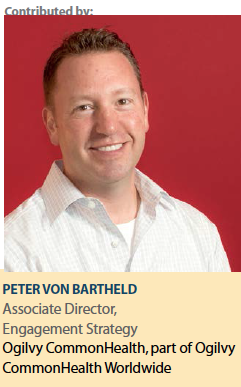Patient-Centric Marketing
 Being a marketer in the pharma industry for over a decade and working with numerous other marketers and dozens of account teams, the one message consistently heard is that each believes their target audience is unique and needs to be “treated" differently. And you know what? They’re right. Not only are these marketers and account teams right about their audiences being unique compared with other audiences, but each patient within these audiences is a unique individual with individual needs and wants that we should be prepared to care for in order to make the greatest impact.
Being a marketer in the pharma industry for over a decade and working with numerous other marketers and dozens of account teams, the one message consistently heard is that each believes their target audience is unique and needs to be “treated" differently. And you know what? They’re right. Not only are these marketers and account teams right about their audiences being unique compared with other audiences, but each patient within these audiences is a unique individual with individual needs and wants that we should be prepared to care for in order to make the greatest impact.
Impact… What Impact?
Impact can have multiple meanings, but here impact refers to behavioral impact (providing the right information to influence a positive shift in patient behavior), as well as persistency and compliance impact, including, for example, a patient using a medical device as prescribed for as long as the doctor has prescribed. The impact of our programs should lead to the best possible healthcare outcomes for patients while building brands for our clients.
What More Do We Need to Know?
So, how do we know which message is the right message for the individual person, you may ask? We learn over time by developing eCRM/CRM programs that engage in two-way dialogues. When both parties, the patients and brand, contribute as active participants to the conversation, the “getting to know you" stage moves significantly quicker (think dating) than if only one side does all the talking (which, historically, is what marketers in pharma have been known to do). Asking questions and providing choices with measureable results throughout the dialogue, we construct a forum for collecting new data, information that ultimately will influence our next steps and our next messaging.
Long gone should be the days of simply pushing messages at our targets and “hoping" patients are interested. Instead, we infuse strategically designed questions and choices to fill all niches and channels with meaningful information into our programs, then frequently analyze the responses (or lack of responses, which are also indicators) to trigger our next deployment of messaging and content.
This Is How We Do It
Being able to deliver a patient-centric program as described above takes considerable thought, design and preparation. Outcomes for different scenarios need to be considered and planned for in order to continue delivering valuable and resonating content. Where smart marketers today are diving into the lakes of data they already have to identify and market to segments within their audience base, we are taking our programs deeper by identifying sub-segments and designing content to speak with patients determined by where they are in their individual lives and therapeutic journeys. Understanding the patient journey and where each patient is within that journey plays a large role in what information is presented.
Ultimately, it all comes down to these 4 steps:
Step 1: Data Discovery
Examine the data you have and/or historical experience to make educated and strategic decisions before developing a patient program.
Step 2: Reporting
Involve a best-in-class Analytics Team early in program development that can provide guidance on which inputs are necessary to get the proper outputs during the reporting stage.
Step 3: Engagement
Build and deploy the program with a continual exchange of data sharing points designed to learn.
Step 4: Optimization
Use key implication reporting outputs to implement appropriate next steps for improving the program and future interactions with the patient audience.
Start with data and end with data. Use dialogue messaging to our advantage and instead of pushing information; allow tactics that are designed for two-way conversations. Use a variety of tactics, channels, devices and platforms for a unified and seamless experience.
Direct Mail — include BRCs for patient recommendations on content and messaging. Consider value-add incentives for participating.
Email — infuse short, quick online surveys and feedback opportunities and keep it simple. If you’re planning a series of emails, consider including a limited number of questions per email, think only one or two, rather than developing and deploying a lengthy questionnaire that may or may not get completed.
Tele — don’t think Tele-Marketing or Tele-Soliciting. Think educated and trained Inside Sales Consultants or Inside Certified Education Managers. When trained properly, to the same extent as your Professional Sales Representatives, these resources can “cover" more territory from a brick-and-mortar location than your typical “feet on the ground."
What’s Next?
While many target audiences can start off viewed as being “the same," by taking a deeper dive and analyzing personalized information, we are able to learn about the audience, and the more “custom-made" our conversations can become. Segments soon can become personas, personas soon become individuals, and over time we have the ability to deliver options and messaging that are relevant and meaningful on a one-to-one level.
Our goal as marketers who want to reach and involve our audiences is to speak with a unique voice to each individual.(PV)
Ogilvy CommonHealth Worldwide — the health behavior specialists of Ogilvy &
Mather — is committed to creativity and effectiveness in healthcare communications, everywhere.
For more information, visit ogilvychww.com


















